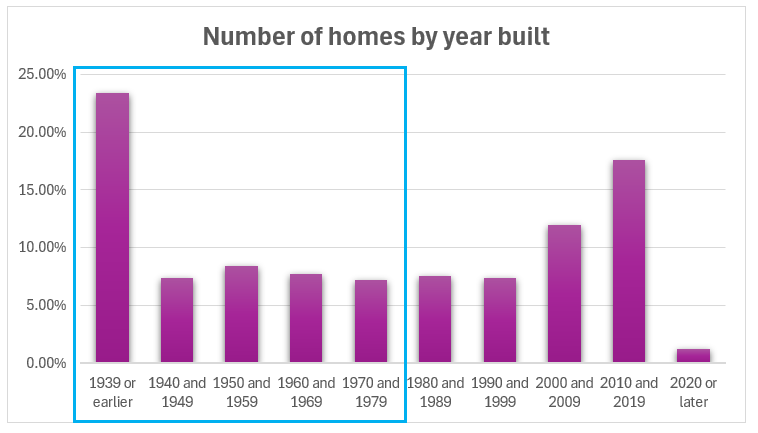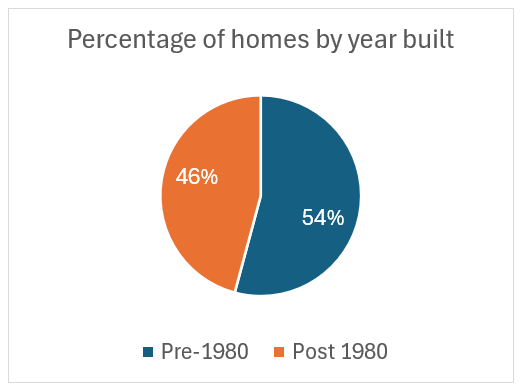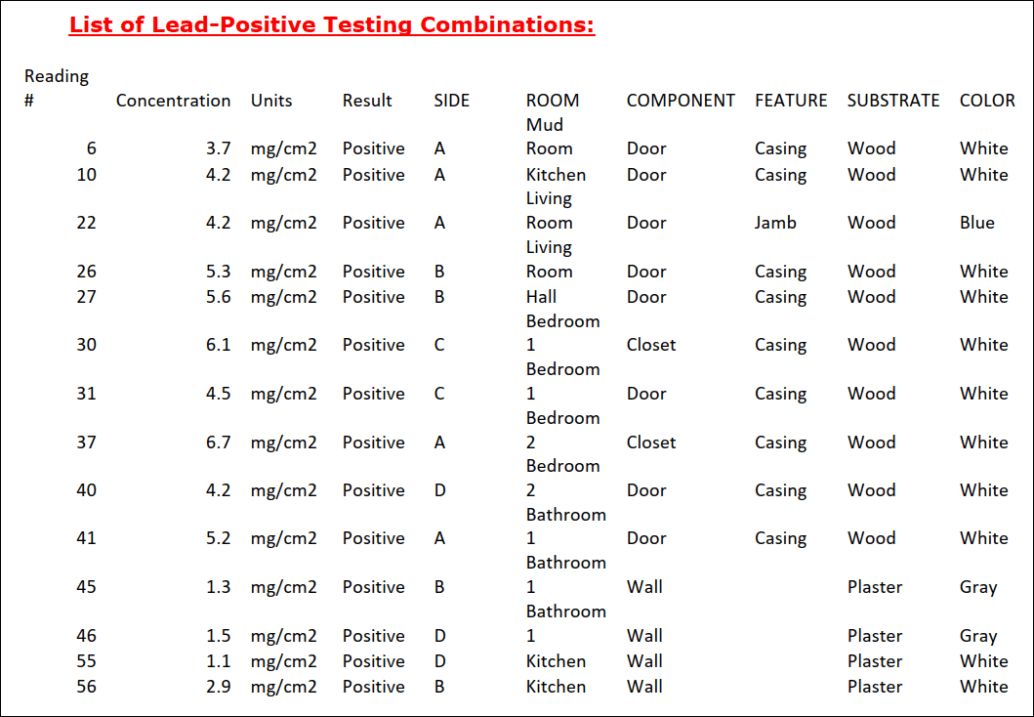Lead Testing Services in Seattle
What is lead toxicity and what does it matter?
Lead was commonly used as an additive to paint until 1978, when it was banned. The chemical element increases the durability of the paint and also provides increased moisture resistance and accelerated dry time. Unfortunately, lead is a toxic substance with no known safe level. The health effects are widespread and have an especially pronounced negative impact on young children.
The information on this page is primarily focused on lead based paint. However, lead exposure can occur in a variety of ways. Although lead based paint was banned in America in 1978, imported products still contain lead today.
Primary exposure routes
- Paint in pre-1978 homes
- Soil near older buildings, airports or busy roads
- Drinking water (pipes, not the water source itself)
- Consumer products, such as jewelry, toys, etc.
Lead based paint risk in Seattle homes
Seattle has relatively old housing stock compared to the Eastside and surrounding areas. This increases the risk of lead based paint, as the age of the home is strongly correlated to the likelihood of lead based paint. The graph below describes the percentage of homes built in each decade. The blue rectangle represents homes with a risk of lead based paint (pre-1978, the year it was banned).
Lead based paint risk is highly dependent upon the individual circumstances of the home. For example, a 1920s home was very likely constructed with lead based paint. However, in many cases the high friction surfaces (i.e. windows and doors) have been replaced since 1978. This greatly reduces the likelihood of lead based paint exposure, effectively narrowing the risk of exposure to remodel projects.
Professional lead testing and inspections services can help detect dangerous lead levels in your indoor and outdoor areas. The Department of Health estimates that around 1.2 million homes have lead-based paint in Washington alone. That’s why it’s important to find a reliable Seattle lead inspection company that provides immediate solutions at affordable prices.
Testing your home for lead based paint
To accurately test your home, we may need to examine hundreds of surfaces that have different paint layers. Historic and tailor-built houses have features like window trims, crown molding, or wainscoting and may, therefore, require more samples.
By using innovative technologies, our team can provide on-site lead testing throughout different areas without scraping or otherwise exposing the paint. Common examples of surfaces and materials tested during lead inspections are:
- Door
- Door jam
- Door trim
- Window (one set per room)
- Window trim
- Windowsill
- Walls (one sample per wall)
- Ceiling
- Wainscoting
- Crown molding
- Floor (if applicable)
- Closets (doors and walls
- Base trim (1 per room)
Types of Lead Paint Tests
The most common ways of testing lead paint in Seattle can be broken down into three methods. These are:
Swab-Style DIY Kits
DIYers may be familiar with swab-style do-it-yourself kits. They often consist of a swab used to collect a sample, which is then dipped into a liquid that changes color in the presence of lead.
Unfortunately, these tests are often inaccurate, to the point that the EPA had to change their recommendations once they discovered how ineffective DIY kits really are. While some hardware stores in Seattle continue to irresponsibly stock these products, we suggest you avoid them altogether.
XRF Testing
X-ray fluorescence testing, simply abbreviated as XRF testing, is regarded as the most effective method for testing lead levels in paint. These devices use intensified x-rays and measure the secondary rays that the surfaces produce back. It’s extremely accurate, instantaneous, and non-destructive, making it the best alternative for the majority of projects.
Paint Chip Sampling
Formerly the standard method for testing lead in Seattle homes, chip sampling involves sanding or scraping a part of the surface. The samples need to be sent to a lab, which usually takes a few days to produce the results.
This type of testing may still be used in small areas that require one or two samples, with XRF becoming the new accepted standard.
Results of XRF lead test we performed on a residential home in Seattle
A typical lead test for a home involves 50-100 samples. The number increases greatly in older, craftsman style homes with many intricate pieces of trim. Each piece is considered a separate material and necessitates an individual scan with the XRF gun.
A XRF test report breaks down the results by the test result status (positive or negative). The image below shows the positive readings from a house.
Drinking water testing is often combined with XRF material testing. Below are the results of a negative lead test.
Health Risks Associated with Lead Exposure
Our bodies absorb lead and store it in our tissues, bones, and even our blood. As we grow older, lead is released due to our bones’ demineralization process.
Once the lead enters the human body for the second time, it’s confused with calcium and other essential compounds. The body may attempt to use the available lead to make bones or create brain connections, resulting in severe health effects.
The worse part is that the symptoms of lead poisoning are similar to those caused by other conditions and develop gradually, so they can be easily missed.
Children
Kids spend a huge amount of time playing on the floor. Being outside, playing in the dirt, and tasting pretty much everything in sight is part of being a child. That, however, also puts them at higher risk of lead exposure. If there is lead-filled soil or paint close to a kid’s playing area, chances are it will end up in his or her mouth.
Lead causes the most harm to children that are six years of age or younger. This is because they are at a critical stage in the growth process. Muscle, bones, and brain connections are constantly being built, so even the lightest levels of lead exposure are associated with symptoms like:
- Growth delays
- Nervous system problems
- Behavioral issues
- Vomiting and nausea
- Seizures and comas
- Brain dysfunction
- Muscle weakness
- Abdominal pain and cramping
Adults
Despite the fact that we have passed the critical stages of growth, adults should also be concerned with extensive lead exposure. Even if the amount of lead needed to cause harm to an adult is much higher than a child, it can still lead to serious health effects. This includes:
- Muscle and joint pain
- Nervous system disorders
- Digestive complications
- Concentration and memory issues
- Fertility problems
- Hypertension
- If pregnant, potential harm to the fetus including brain damage and death
Soil Lead Testing in Seattle
Paint is not the only source of lead you may have to monitor. The soil around your house can contain high lead levels, which have become a huge problem thanks to the growing popularity of functional gardens in Seattle.
Deteriorating House Paint
Leaded paint that chips, peels, or disintegrates may contaminate the soil around your house. This is even truer if the paint is removed via pressure washing, sanding, or scraping. Multiple studies conclude that lead levels around a house tend to be higher within 2 to 3 feet of the building.
Industrial Generators
Industrial facilities tend to release a huge quantity of lead into the atmosphere. After some time, these particles settle on the ground and are absorbed by the soil. Many smelter operations, such as Asarco Inc. located in Tacoma, are listed as potential sources of lead pollution that may affect Seattle and the entire region.
Leaded Gasoline Residue
Leaded fuels were only banned in the 1980s. Dangerous lead particles were constantly released by combustion engines for decades, resulting in elevated lead concentrations in the soil close to major roads and highways.
A Brief Explanation of Soil Lead Tests
Soil lead testing in Seattle is slightly different than paint inspections, and they can be categorized into two groups. These are:
- In-Situ Tests: Also known as on-site tests, these examinations are conducted using an XRF analyzer that is pointed at the soil. Besides providing instant results, this technique also complies with the standards set by the US EPA Method 6200 to locate contamination boundaries.
- Ex-Situ Tests: These tests are carried out off-site and may take a few days because the samples are sent to a lab. It’s worth noting that multiple samples are required to get an accurate representation of the area. These tests may be more accurate than in-situ tests, but they also provide slower results.
How Does Lead-Contaminated Soil Affect Your Household?
Humans usually suffer symptoms of lead exposure after ingestion. Children that are 2 to 3 years old are at the highest risk because of the increased probability of ingesting soil or dirt.
Moreover, pets and children can also track fine lead particles back into your house. These airborne particles can settle close to the entry points, so testing these areas can give you a good indication of whether or not this is the case.
Lead Testing FAQs
What defines safe lead levels in the garden?
Lead is a naturally occurring element that can be present in the soil, with concentrations that range between 7 and 20 parts per million (ppm).
Research suggests that garden crops can be grown safely in soil with total lead levels under 300 ppm. In Washington State, the unrestricted site use cleanup levels for lead are 250 ppm.
When should I test my house for lead?
Lead testing in Seattle is a good idea if you:
- Have infants or small children
- Live close to a busy road and you plan to grow vegetables and fruits
- Start a remodeling project, regardless of the size
- Want to buy a house built before 1979
What isn’t included in the inspection?
Most lead inspections in Seattle don’t assess non-permanent structures like furniture or areas like soil and water bodies. However, we believe these are all critical to evaluating your home’s safety, so our inspections do include these parts of your home.
Which fruits and vegetables and more susceptible to lead contamination?
Leafy greens and roots are more likely to carry high concentrations while fruits don’t normally accumulate lead particles.
Can I prevent lead exposure from my garden?
Lead contaminations often occur due to the soil and dirt covering your crops. You can reduce the chances of exposure by rinsing and washing your garden veggies and fruits before consuming them.
If you’re still worried about lead levels, you can wash all greens in a water and vinegar solution as well as peel all root crops before cooking them.
Get in Touch with Environix Today
Contact Environix today and our seasoned team of Seattle lead inspectors will be glad to test your home. Get in touch with us by giving us a call at 800-351-9563 or schedule an appointment with an expert today!
Success Stories
"Tim was GREAT and an invaluable resource of information! He was able to debunk all of the obtuse statements being made by ‘the other expert’ (for the defense) and prove where and how the mold occurred and spread throughout the house. It was great meeting him and I hope he passed on our thanks to everyone there!"
– Shari T.






